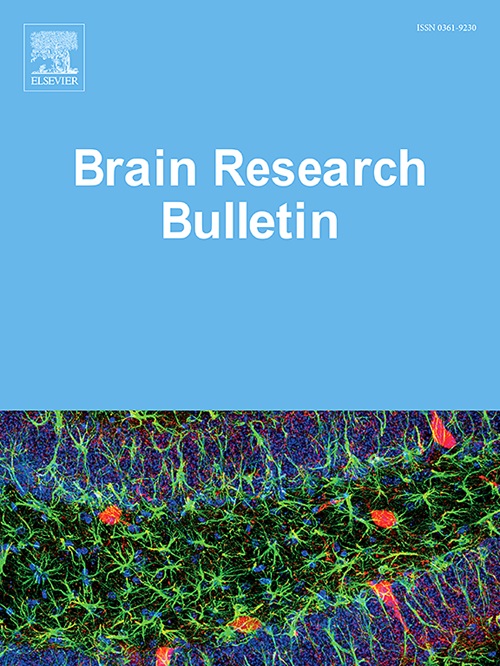阻断PVN神经素B受体可通过RAS/ROS/NF-κB途径减轻自发性高血压大鼠的炎症反应。
IF 3.5
3区 医学
Q2 NEUROSCIENCES
引用次数: 0
摘要
神经药物B (Neuromedin B, NMB)通过促进高血压和交感神经兴奋作用,对心血管疾病的发生有潜在的重要影响。然而,关于NMB在室旁核(PVN)中功能的研究尚缺乏。使用选择性神经介质B受体(NMBR)拮抗剂BIM-23127,我们旨在确定阻断PVN中NMB功能是否可以减轻中枢性炎症和减轻高血压反应。将自发性高血压大鼠(SHR)和Wistar Kyoto大鼠(WKY)在PVN内长期注射BIM-23127 6周。用尾袖带和电生理采集系统评估平均动脉压(MAP)。收集PVN组织,分析Fra-LI、炎症细胞因子(IL-1β、TNF-α、IL-6、IL-10和IL-4)、肾素-血管紧张素系统(血管紧张素转换酶(ACE)、ACE2和at1报告因子(AT1-R))和氧化应激(活性氧(ROS)、超氧化物歧化酶(SOD)1、NADPH氧化酶(NOX)2和NOX4)的表达。ELISA法检测血浆和PVN组织匀浆中炎症指标、去甲肾上腺素(NE)、核因子κB (NF-κB) p65。与WKY相比,SHR表现出更高的平均动脉压(MAP)、血浆NE和促炎细胞因子(PICs)。SHR患者PVN中fr - li、PICs、ACE、AT1-R、ROS、NOX2、NOX4和NF-κB p65水平升高,而抗炎细胞因子(aic)、ACE2和SOD1水平降低。在PVN中给予BIM-23127逆转了SHR的所有这些变化。在SHR中,阻断PVN的NMBR抑制交感神经兴奋并减轻高血压反应。其抑制机制可能与减少PVN的炎症和RAS/ROS/ NF-κB通路有关。本文章由计算机程序翻译,如有差异,请以英文原文为准。
Blockade of PVN neuromedin B receptor alleviates inflammation via the RAS/ROS/NF-κB pathway in spontaneously hypertensive rats
Neuromedin B (NMB) has potentially great impacts on the development of cardiovascular diseases by promoting hypertensive and sympatho-excitation effects. However, studies regarding the NMB function in paraventricular nucleus (PVN) are lacking. With selective neuromedin B receptor (NMBR) antagonist, BIM-23127, we aim to determine whether the blockade of NMB function in PVN could alleviate central inflammation and attenuate hypertensive responses. Spontaneously hypertensive rats (SHR) and Wistar Kyoto rats (WKY) were chronically infused with BIM-23127 in the PVN for 6 weeks. Mean arterial pressure (MAP) was assessed with tail cuff and electrophysiological acquisition systems. PVN tissues were collected to analyze expressions of Fra-LI, inflammatory cytokines (IL-1β, TNF-α, IL-6, IL-10, and IL-4), renin-angiotensin system (angiotensin-converting enzyme (ACE), ACE2, and AT1-reporter (AT1-R)) and oxidative stress (reactive oxygen species (ROS), superoxide dismutase (SOD)1, NADPH oxidase (NOX)2, and NOX4). ELISA was used to detect inflammation indices, norepinephrine (NE), and nuclear factor κB (NF-κB) p65 in plasma and PVN tissue homogenate. Compared to WKY, SHR exhibited higher mean arterial pressure (MAP), plasma NE, and pro-inflammatory cytokines (PICs). Higher PVN levels of Fra-LI, PICs, ACE, AT1-R, ROS, NOX2, NOX4, and NF-κB p65, while lower central levels of anti-inflammatory cytokines (AICs), ACE2, and SOD1 were observed in SHR. Administration of BIM-23127 in PVN reversed all these changes in SHR. In SHR, blockade of NMBR in the PVN inhibited sympatho-excitation and attenuated hypertensive response. The attenuation mechanism may involve reducing inflammation and the RAS/ROS/ NF-κB pathways in PVN.
求助全文
通过发布文献求助,成功后即可免费获取论文全文。
去求助
来源期刊

Brain Research Bulletin
医学-神经科学
CiteScore
6.90
自引率
2.60%
发文量
253
审稿时长
67 days
期刊介绍:
The Brain Research Bulletin (BRB) aims to publish novel work that advances our knowledge of molecular and cellular mechanisms that underlie neural network properties associated with behavior, cognition and other brain functions during neurodevelopment and in the adult. Although clinical research is out of the Journal''s scope, the BRB also aims to publish translation research that provides insight into biological mechanisms and processes associated with neurodegeneration mechanisms, neurological diseases and neuropsychiatric disorders. The Journal is especially interested in research using novel methodologies, such as optogenetics, multielectrode array recordings and life imaging in wild-type and genetically-modified animal models, with the goal to advance our understanding of how neurons, glia and networks function in vivo.
 求助内容:
求助内容: 应助结果提醒方式:
应助结果提醒方式:


